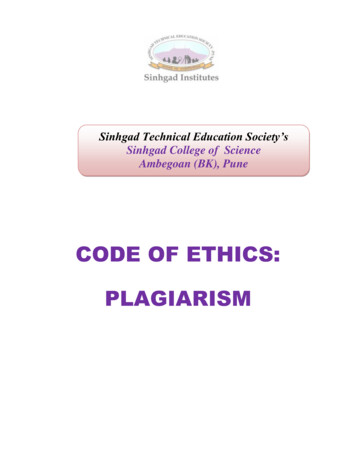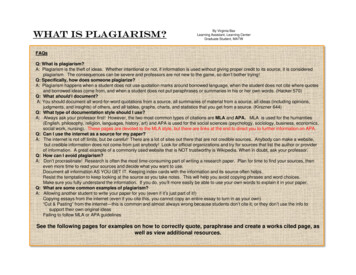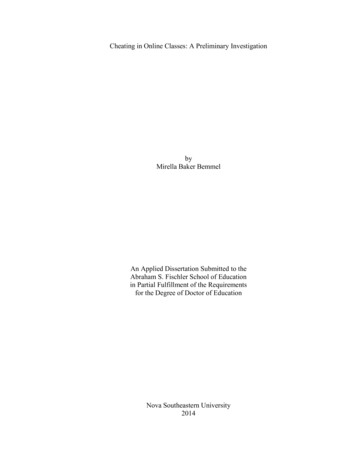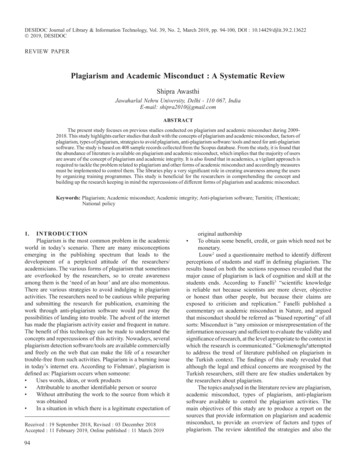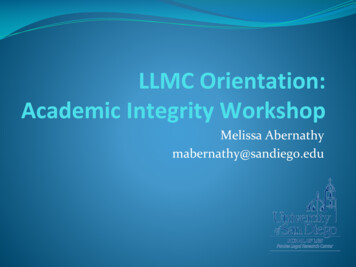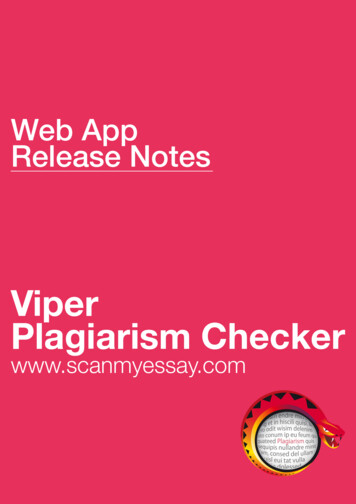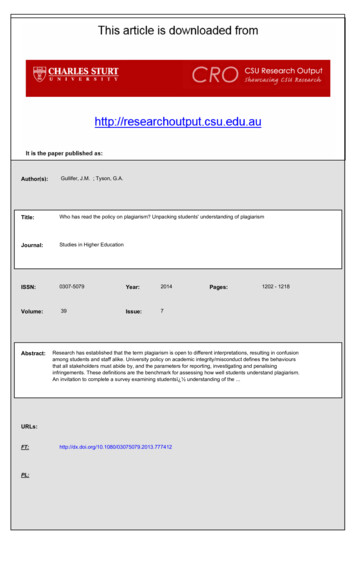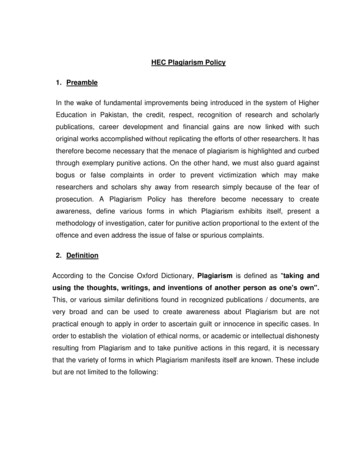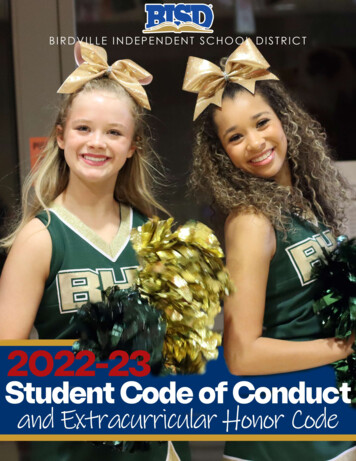
Transcription
Academic Dishonesty, Cheating, and PlagiarismByLars R. Jones, Ph.D.WithRobert Taylor, Ph.D.Sharon Irvin, M.A.Leslie FairclothHumanities & Communication DepartmentFlorida Institute of TechnologyMelbourne, FloridaCopyright August 2001
The authors wish to acknowledge the assistance, suggestions, andcontributions of the following people:Bradford Allen, Ph.D.; Clayton Baum, Ph.D.; Penny Bernard, M.S.;Eugene S. Cavallucci (Harris Corp.); Donald F. Dement, Ph.D.;Nicole Hoier, Ed.S.; Capt. Robert D. Jordan (U.S. Army ROTC);Nabil Matar, Ph.D.; George Maul, Ph.D.; Mary Mullins, M.A.;Douglas A. Nolder, M.S.; Dee Dee Pannell, M.B.A.;Gordon Patterson, Ph.D.; Alan Rosiene, Ph.D.;Doreen Russell, M.S.; Dan Vitkus, Ph.D.iii
What is academic dishonesty?DefinitionAcademic dishonesty includes "cheating" and "plagiarism," the theft of ideasand other forms of intellectual property— whether they are published or not.Florida Tech's Academic Advising Handbook says, "Cheating and/or plagiarismare extremely serious matters. Even the suspicion of cheating or plagiarizinghas jeopardized promising careers. The university has an obligation to itself, itsalumni and its students to deal with such cases with unmistakably clear,forthright and fair action."1According to Florida Tech's Student Handbook, "All forms of academicdishonesty, including cheating, fabrication, facilitating academic dishonesty andplagiarism are subject to disciplinary action up to and including suspension orexpulsion from the university."2 Similarly, U.S. Army ROTC regulations state"cheating" and "any forms of academic dishonesty" are indicators of"undesirable character" that can result in "disenrollment" from the program.3ExampleYour best friend is having trouble in a class and needs a “C” to keep herathletic scholarship. She asks if she can copy off your exam “just thisonce.”You agree since you think you aren’t doing anything wrong. Is thischeating? Yes. By allowing someone to copy off your exam, you areguilty of giving information and are thus cheating.What is cheating?Definition1Cheating includes the following: giving or receiving information during an exam ("exam" includes tests andquizzes) using unauthorized material (like notes) during an exam; unauthorizeddissemination or receipt of exams, exam materials, contents, or answer keys taking an exam or writing a paper for another student or asking someone totake an exam or write a paper for you (this includes shared work and/orgroup-produced answers on take-home exams). submitting the same paper–or different versions of what is substantially thesame paper–for more than one course misrepresenting or fabricating written work, sources, research, or results aswell as helping another student commit an act of academic dishonesty orlying to protect a student who has committed such an act.
What are the penalties for cheating?PenaltiesThe penalties for cheating are at the instructor’s discretion. Depending on theseverity of the infraction, the penalties range from receiving an "F" (0 points) onthe exam or the assignment to receiving an "F" grade in the course. Cases ofcheating may be forwarded to the Dean of Students Office and could result inthe student’s suspension or expulsion from Florida Tech.What is plagiarism?DefinitionPlagiarism is "[t]he use of another writer’s words or ideas withoutacknowledging the source" and is "[a]kin to theft," according to the HarbraceCollege Handbook.4 In Writing with Sources, plagiarism means "passing off asource’s information, ideas, or words as your own by omitting to cite them—anact of lying, cheating, and stealing."5His words "I CAME, I SAW, I CONQUERED" express hisincredibly strong will and no-nonsense attitude. student paper"I came, I saw, I conquered!" These words express theincredibly strong will and no-nonsense attitude of one ofhistory's most famous men. mply put, plagiarism is the theft of intellectual property belonging to another.This includes both the theft of unwritten ideas and concepts as well as the theftof written texts, notes, computer programs, designs, and/or visual materials. Inmost cases, the theft of intellectual property is intentional and, in some cases,malicious in its nature. Such students simply don’t think they will get caught. Insome cases, the theft of intellectual property seems to be the result of ignoranceand could have been avoided had the student better understood the nature ofplagiarism. Since instructors cannot know what a student really intended to do,they have no choice but to treat each case of plagiarism as a serious offense.According to one professor, "Ignorance of plagiarism and its penalties tends toplay a minor role in the cases I have encountered at Florida Tech. More often,plagiarizers have difficulty writing and managing their time well. Usually theyhave become desperate and copied madly at midnight to fill the requisite pagesby daybreak. Sometimes they are ignorant of plagiarism and its penalties, butupon further investigation, one discovers this failing to be just one among themany possible effects of their general cluelessness."62
What are the penalties for plagiarism?Penalties"Plagiarism is aserious offense.Carelessness isno excuse." 7Again, the penalties for plagiarism are at the instructor’s discretion. Dependingon the severity of the infraction, the penalties for acts of plagiarism that seemintentional range from an "F" (0 points) on the assignment to an "F" grade forthe course. Even minor and seemingly unintentional acts of plagiarism are likelyto be rewarded with an "F." Acts of plagiarism that seems intentional will beforwarded to the Dean of Students Office with a recommendation for formaldisciplinary action."Taking someone else’s words or ideas," according to the Harbrace CollegeHandbook, "and presenting them as your own leaves you open to criminalcharges. In the film, video, music, and software business this act of theft iscalled piracy. In publishing and education it is called plagiarism and/orcheating. Whatever it is called and for whatever reason it occurs, it is wrong.Although the act may escape criminal prosecution, employers generally fire anemployee who uses material illegally, and teachers often fail careless students."8Taking an example from technology industry, Harris Corporation’s Standards ofBusiness Conduct states that “Patents, Copyrights and Trademarks are protectedby the laws of the United States. Unauthorized copying, manufacture, use . [ofprotected items] will subject Harris to civil and criminal liability." Employees inviolation of such standards risk "disciplinary actions, including suspensions,termination, civil liability or criminal prosecution."9 On August 11, 2000, a sixmember jury ruled that The Walt Disney Co. stole ideas for a sports complexfrom two businessmen and should pay 240 million in damages.10Types of Plagiarism1. Unauthorized and/or unacknowledged collaborative work constitutesplagiarism. While students are expected to do their own research andwriting, instructors also understand that students may discuss their ownresearch projects with other students in the same course. Instructors stronglysuspect collaborative plagiarism when the same or similar phrases,quotations, sentences, and/or parallel constructions appear in two or morepapers on the same topic. To protect yourself, you should acknowledge—ina footnote or endnote—any significant discussions you have had with othersas well as any advice, comments, or suggestions that you have received fromothers.2. Attempting to pass off, as your own work, a whole work or any part of awork belonging to another person or group constitutes plagiarism. Thisincludes borrowing, buying, copying, receiving, downloading, taking, using,and/or stealing a paper that is not your own.The use of ANY AMOUNT OF MATERIAL—either without a citation orcited improperly—TAKEN DIRECTLY from a text, from the web or a3
digital source, from a broadcast, recording, or from another person’sunpublished work constitutes plagiarism.Example ASource TextPlagiarizedVersion11Example BExample CStudent's WorkExample DThe use of such material without any attribution, citation, acknowledgmentor quotation marks is plagiarism. You must use quotation marks on ANY texttaken directly from another source, even from the course textbooks; moreover,such material must be cited.“A worldwide increase in toxic phytoplankton blooms over thepast 20 years has coincided with increasing reports of fishdiseases and deaths of unknown cause.”-abstract of a paper by J. M. Burkholder, et. al. (1992),Nature, 358:407410.A worldwide increase in toxic phytoplankton blooms overthe past 20 years has coincided with increasing reports offish diseases and deaths of unknown cause.The use of such material with false attributions/citations and/or the use ofdeceptive or fabricated citations to disguise direct plagiarism is stillplagiarism. Students who intentionally plagiarize often attempt to disguise theplagiarized material in their papers with fake citations.The use of such material with quotation marks but without any attribution,citation, or with inadequate/improper attribution/citation is consideredplagiarism. You must use proper citations for all quoted and paraphrasedmaterial taken from another source. In the following example, the student usedquotation marks and seems to cite the quoted text but, by neglecting to refer tothe page from which this quotation was taken, has failed to cite properly. Failingto cite properly throughout the paper earned this student an "F."Once in Egypt he murdered Cleopatra’s son Ptolmey and annexedEgypt under his direct power. Once he took all of Egypt’s money he paidoff everyone he was endebted to and “ finally became the master of allthe Greco-Roman world”(The Deeds of the Divine Augustus, Augustus).The use of such material—correctly attributed and properly cited—butwithout quotation marks is plagiarism. You must use quotation marks onANY amount of text taken from another source. In the following example, thestudent cited material that was copied, in large part, directly from the source textbut the student failed to indicate the quoted material by using quotation marks.The student pretended to be paraphrasing but was really plagiarizing. Had thestudent used quotation marks, the paper would not have received an "F."4
Student's WorkIX. For all that, he presently made a more daring attempt at Rome: for a few days before he entered upon hisaedileship he was suspected of having made a conspiracy with Marcus Crassus, an ex-consul, and likewisewith Publius Sulla and Lucius Autronius, who, after their election to the consulship, had been found guilty ofcorrupt practices. The design was to set upon the senate at the opening of the year and put to the sword asmany as they thought good; then Crassus was to usurp the dictatorship, naming Caesar as his master ofhorse, and when they had organized the state according to their pleasure, the consulship was to be restoredto Sulla and Autronius. This plot is mentioned by Tanusius Geminus in his History, by Marcus Bibulus in hisedicts, and by Gaius Curio the elder in his speeches. Cicero too seems to hint at it in a letter to Axius, wherehe says that Caesar in his consulship established the despotism which he had had in mind when he wasaedile. Tanusius adds that Crassus, either conscience-stricken or moved by fear, did not appear on the dayappointed for the massacre, and that therefore Caesar did not give the signal which it had been agreed thathe should give; and Curio says that the arrangement was that Caesar should let his toga fall from hisshoulder. Not only Curio, but Marcus Actorius Naso as well declare that Caesar made another45Source Text12Conspiracy and bribery were very popular tools used by Caesar prior to hisreign as Imperator. For instance just before he entered aedileship he wassuspected of having made a conspiracy with Marcus Crassus, an ex-consul,and with Publius Sulla and Lucius Autronius, who were found guilty ofcorrupt practices. The plan supposedly was to kill as many of the senate asthey though good, then for Crassus to usurp power and then declareCaesar his master of horse. Further when they had reorganized the stateaccording to their own pleasures, then they would restore the consulship toSulla and Autronius. This particular plot did not actually occur, because,and it is suggested in Suetonius, that Crassus was either consciencestricken or moved by fear and consequently did not show up for the plannedmassacre6.Example A5Suetonius 436This paragraph was mostly based on info from page 45.3.The use of ANY AMOUNT of text that has been IMPROPERLYPARAPHRASED constitutes plagiarism. Suggesting an improper reliance ona single source, this includes "mosaic plagiarism" or "cut-and-paste plagiarism."To paraphrase improperly is simply to put the words of a source text in adifferent order or form while retaining the main idea that is the intellectualproperty of the original author/translator. When you simply alter the textitself (but not the author’s idea), all that you have done is to eliminate theobvious need for quotation marks; you have not eliminated the need for anexplanatory citation/attribution! The idea itself remains the intellectual propertyof the original author/translator and, therefore, must be cited as such. In theprevious example, the student assumed that by simply changing a few words5
in the source text there was no need to use quotation marks in the paper. Notonly are significant portions of the student’s text lifted directly from the sourcetext but the structure of the source text is followed too closely as well.According to the Harbrace College Handbook, "[a] paraphrase is a restatementof a source in about the same number of words. [ ] Your paraphrase ofsomeone else’s work should honor two important principles: Your versionshould be almost entirely in your own words, and your words should accuratelyconvey the content of the original passage. [ ] Unless you enclose an author'swords in quotation marks, do not mix them with your own even if the sentencestructure is different. Equally important, do not make the mistake of thinkingthat you can substitute synonyms for an author’s words while you preserve hisor her sentence structure. Both of these are plagiarism, even if you cite thesource."13To paraphrase properly, your work must contain a distinctly different idea thatis, the paraphrase must contain your original idea. Simply changing the wordorder or sentence structure/order, deleting words or phrases, and/or substitutingsynonyms is not enough if the original author's idea remains unchanged in"your" text. If you can't find a way to paraphrase it properly, then quote it andcite it. Cutting and pasting together improperly paraphrased texts from multiplesources only compounds the severity of the offense.In the following example, the student in a physical chemistry lab course copiedmaterial, in large part, directly from a student report submitted the previousyear. The chemical compound used in the experiment was different but theobjective and the procedure remained the same. Although a few words in eachsentence and a few characters in each equation were changed, the ideas andselection of equations are clearly identical. This is considered plagiarism andnot simply paraphrasing.Student’s WorkIntroductionThe purpose of this experiment is to measure the molar heat of combustion ofmaleic acid. In order to find this quantity. the heat capacity (Cs) of thecalorimenter must first be measured. This was found using the followingequation:(1) Cs ( E(ben) E(wire))/T2-T1Where E(ben) represents the internal energy of benzoic acid and E(wire)represents the internal energy of the wire holding the benzoic acid duringcombustion. The variable T is the temperature. T2 being the ending temp. andT1 being the starting temp. both in Celsius. For these samples the amounts ofbenzoic acid, maleic acid and wire were all known.The heat of combustion was then calculated from the following equation:(2) E Cs(T2-T1) – E(wire)Where Cs is the average value of the heat capacities found in the first equation.When the heat of combustion is quantified it is now possible to find the molar heatof combustion, also known as enthalpy or H. This is found using the followingequation:(3) H E RT nWhere n is the change in moles for the system found by stoichiometry and R isthe universal gas constant in Joules/mol*Kelvin.6
Source TextIntroductionThe purpose of this experiment is to measure the molar heat of combustion ofNaphthalene. In order to do this, the heat capacity (Cs) of the calorimeterneeded to be determine through the use of the following formula:(1) Cs ( Eba Ewire) / (T2-T1)Where Eba represents the known heat of combustion of benzoic acid andEwire represents the heat of combustion for the wire holding the benzoic acidpellet during combustion. The variable T represents the temperature in Celsiusbefore and after the trial. The procedure for this determination involvescombustion of each of the samples within a bomb colorimeter. For suchsample, the amounts of benzoic acid, naphthalene, and wire were known.The heat of combustion ( E) was then calculated from the following equation:(2) E Cs (T2 – T1) - EwireWhere Cs is the average value of the heat capacities determined through theuse of equation (1). Once the heat of combustion for naphthalene is determinedwe can determine the molar heat of combustion ( H) represented through thefollowing equation:(3) H - E RT nwhere n is the change in moles for the system and R is the universal gasconstant in Joules. Due to the fact that the pressure within the system is notconstant we can not assume that H is equal to E, and will be determined in kJper mole naphthalene.The following is an example of "mosaic" or "cut-and-paste" "plagiarism. Thestudent has stitched together texts from two web sites—copying directly,paraphrasing improperly, and failing to cite. The only citation is false—anattempt to disguise and authenticate the plagiarized passages.Student’s WorkSource Text ASource BSources A BSources A B7Julius Caesar was born on July 13 in the year 100 BC. His full name wasGaius Julius Caesar, the exact same name as his father. Although patricianand claiming descent from Venus, Caesar’s family never achieved realprominence. Around 86BC Caesar’s uncle Marius, just before his death, sawto it that young Caesar was appointed flamen dialis, one of an archaicpriesthood with no power. This then identified him with his uncle’s extremistpolitics. Julius Caesar’s father died in 85 BC. In 84 BC, at the age of sixteen,he married Cornelia, the daughter of Lucius Cornelius Cinna, one of Marius’associates. This marriage further confirmed him as a radical. Soon after hismarriage he had a daughter, Julia. When Lucius Cornelius Sulla, Marius’senemy and leader of the Optimates, was made dictator in 82 BC, he issued alist of enemies to be executed. Although Caesar was not harmed, he wasordered by Sulla to divorce Cornelia. Refusing that order, he found it prudentto leave Rome. He did not return to the city until 78 BC, after Sulla’sresignation. (Plutarch wrote in more detail about this in his work, The Lives ofthe Noble Grecians and Romans.)
ce Text ATHE POWER OF CAESARJulius Caesar rose from relative obscurity to supreme poor in thelate Roman republic. A brilliant general and formidable politician, hedefeated all rivals to become dictator of Rome. Fear that he wouldmake himself king prompted his assassination in 44 BC. ButCaesar's adopted son, Octavian, later rose to become the emperorAugustus.Early LifeGaius Julius Caesar was born on July 13, 100 BC. Althoughpatrician and claiming descent from Venus through Aeneas's sonIulus (Ascanius), Caesar's family had not achieved real prominence.His father, also named Gaius Julius Caesar, was the brother-in-lawof Gaius Marius and married Aurelia, who was connected with theprominent Aurelii family; he died about 85 BC, however, beforereaching the consulship. In 84, Caesar married Cornelia, daughterof Marius's old partner Lucius Cornelius Cinna. When LuciusCornelius Sulla ordered him to divorce her, he refused and escapedharm through the intervention of such people as his mother'srelative, Gaius Aurelius mlSource Text B8
Improper paraphrasing often results from the use of a single source. Insuch cases, it is virtually impossible to separate your own ideas from those ofthe author and/or translator. This form of plagiarism is especially apparentwhen the order and structure of a student’s paper (or even part of a paragraph) isvirtually identical to that of the source text.Example BWhen Professor Richard M. McMurry was asked to review the book War SoTerrible: Sherman and Atlanta by James Lee McDonough and James PickettJones (since withdrawn), McMurry discovered much of the book had been"pilfered" from his own doctoral dissertation. This example from War SoTerrible, reproduced in McMurry’s review, is an excellent example of improperparaphrasing and structural paraphrase plagiarism.144.The use of any amount of text, that is properly paraphrased—butwhich is either not cited or which is improperly cited—constitutesplagiarism. This includes papers in which a general failure to citesources or a gross negligence in citing sources is apparent. Moreover,attaching false, misleading, or improper attributions/citations to properlyparaphrased texts still constitutes plagiarism.When is plagiarism suspected?Instructors may suspect a student of plagiarism if you do one or more of thefollowing:Plagiarism Signs91. Use or turn in a paper from a previous year or from another course.Instructors talk with one another and many keep copies of papers on file—just like fraternities, sororities, and other groups. If you must use somethingfrom someone else’s work, cite it properly as the work of another!
Include citations and/or title pages typed/printed in different fonts and typesizes than the body of the paper. Students who do not take the time to researchand write their own papers usually do not take the time to correct citations andfix inconsistent fonts.2. Use words and concepts that are not likely to be understood in anintroductory course. This is readily noticed by professors.3. Write a paper in a distinctly different style. Every student has a unique"style" of writing an intellectual fingerprint. After reading papers andexams throughout the semester, instructors come to know the particularwriting styles of their students.4. Use the same or similar passages that "coincidentally" another studentused in a paper. When plagiarizing from the web or from books, somestudents seem to think that they live in a vacuum! When tempted toplagiarize a "great" passage from a web site or a book, remember that youare not alone—someone else is bound to think and do the same thing.5. Include conflicting or contradictory passages—especially when writtenin different "voices" or "styles."What about "common knowledge"?DefinitionAccording to the Harbrace College Handbook, "Common knowledge includessuch information as ‘December has thirty-one days,’ and well-known proverbs(‘a penny saved is a penny earned’) or historical information such as the date ofthe Declaration of Independence."15Beware of the popular myth: "if it appears in three different sources, then it’scommon knowledge and I don’t have to cite it." Don’t look for reasons not tocite; this will only cause you problems. If you are in doubt about whether to citesomething, the rule is that you should cite it.Don’t assume anything you read—especially on the web or in your textbooks—is common knowledge. Many texts on the web are simply plagiarized from otherpages or from printed sources. If you have any questions, ask your instructor."I write,therefore Icite."According to The Holt Handbook, you need not document your own opinion,ideas, observations, and conclusions but you must document:16 direct quotations opinions, judgments, and insights of others that you summarize orparaphrase10
Quality paperscannot be rushed. information that is not widely known information that is open to dispute information that is not commonly accepted tables, charts, graphs, statistics taken [directly or paraphrased] from a sourceKeep in mind, however, that the use of too much material requiring quotationmarks and attributions/citations is an indication that too few of your ideas arepresent in the paper. Students who plagiarize intentionally usually do so simplybecause they have not thought enough about their papers—either because theydidn’t want to spend the time on it or because they waited until the last minute.How to use and cite sources properlyThree PrinciplesIn Writing with Sources, "three basic principles" are given for the proper use ofsources.171. "Use sources as concisely as possible, so your own thinking isn’t crowdedout by your presentation of other people’s thinking, or your own voice byyour quoting of other sources."2. "Never leave your reader in doubt as to when you are speaking and whenyou are using materials from a source."3. "Always make clear how each source you use relates to your argument."Be sure to use the proper citation format designated by your instructor. Allstudent work–whether written, oral, or digital–must contain proper citationsand/or attributions. Some instructors require their students to use "in-textcitations." In-text citations are an abbreviated form of citation usually containingonly the author’s name and the relevant page number (publications dates mayalso be required in some instances). Example of in-text citations referring to thispage of this publication are (Jones 11) and, in APA style, (Jones, 2000, 11).When using in-text citations, be sure to include a bibliography in which you givethe full publication information. In-text citations are treated in the HarbraceCollege Handbook, 485–574.Some instructors require their students to use "endnotes" or "footnotes" for theircitations. Endnotes and footnotes tend to be explanatory in nature althoughsome footnotes and endnotes may only contain simple citations of editions andpage numbers. Be sure to include a bibliography if required by yourprofessor/instructor. If no bibliography is required for the assignment, be sure togive full publication information in the first footnote or endnote. For footnoteand endnote style, consult your professor/instructor and the Harbrace CollegeHandbook, 538–541.11
The Harbrace College Handbook is the required text for Com 1100, 1101, 1102and should be kept and used as a reference in future courses at Florida Tech.Copies of the Harbrace College Handbook are on reserve in Evans Library anda copy is also available for consultation during regular business hours at theDepartment of Humanities and Communications and the Academic SupportCenter.12
Endnotes1Florida Institute of Technology, Academic Support Center, Academic Advising Handbook,August 1999, 14.2Florida Institute of Technology, Student Handbook, 1999, 33. According to the StudentHandbook, students are responsible for knowing all Florida Tech rules and regulations concerningacademic dishonesty (see 33 & 43 44). Moreover, the Student Handbook says that ignorance is notan excuse for a violation of these rules and regulations (1).3U.S. Army Regulation 145-1, Section VI, paragraph 3–43 a (14).4John C. Hodges, et al., Harbrace College Handbook, 13th Edition, 1998, G-38. Plagiarismis treated on 472 483.5Gordon Harvey, Writing with Sources; A Guide for Harvard Students, 1995, 21. (Thissource is also available on-line at http://icg.harvard.edu/ sources/)6Alan Rosiene, letter, March 20, 2000; used with permission.7Hodges, et al., 472 473.8Hodges, et al., 472.9Harris Corporation, Standards of Business Conduct, 1999, 21 & 26. Used by permission ofHarris Corp.10"Disney Stole Sports Complex Ideas," CNBC & The Wall Street Journal Business (August18, 2000) http://www.msnbc.com/news/444904.asp.11Adapted from the Division of Marine and Environmental Systems "Policy Statement onPlagiarism," January 1999, 2.12Suetonius, Lives of The Caesars, I.IX (J.C. Rolfe, ed. & trans.), Cambridge, Mass.,Harvard University Press, 1998, 45.13Hodges, et al., 479 480. The Harbrace College Handbook, on 480 483, discusses“inadequate paraphrasing,” “adequate paraphrasing,” and “summarizing.”14See Richard M. McMurry, review of War So Terrible: Sherman and Atlanta by James LeeMcDonough and James Pickett Jones (New York & London: W.W. Norton & Company, c. 1987),Journal of Southern History 60, no. 2 (1989): 337 338.15Hodges, et al., 473 474.16Mary Mullins, unpublished handout, p. 5, citing Laurie G. Kirszner & Stephen R. Mandell,The Holt Handbook, 3rd ed., Fort Worth, 1992, 562 570.17Harvey, 3 4.13
Further ResourcesFlorida Institute of Technology, Academic Support Center, "Academic Advising Handbook,"August 1999.Florida Institute of Technology, Division of Marine and Environmental Systems, "Policy Statementon Plagiarism," January 1999.Florida Institute of Technology "Student Handbook," 1999.Harvey, Gordon. Writing with Sources: A Guide for Harvard Students. Harvard University, 1995 http:/cg.harvard.edu/ sources/ Hodges, John C., et al., Harbrace College Handbook, 13th Ed., 1998, 472 483.Schachman, H. K., Science 261 (1993): 148-149.WWW.canexus.comThis Essay Verification Engine is designed to break a paper down and detect even plagiarized wordfragments.WWW.cs.berkeley.edu/ aiken/moss.htmlThe MOSS program can be used in computer science courses to uncover plagiarism in computerprograms.WWW.dogpile.comA collection of search engines offering free key word searches of numerous web sites on theInternet.WWW.Integriguard.comA private company that labels its ser
Florida Tech's Academic Advising Handbook says, "Cheating and/or plagiarism are extremely serious matters. Even the suspicion of cheating or plagiarizing has jeopardized promising careers. The university has an obligation to itself, its alumni and its students to deal with such cases with unmistakably clear, forthright and fair action."1
